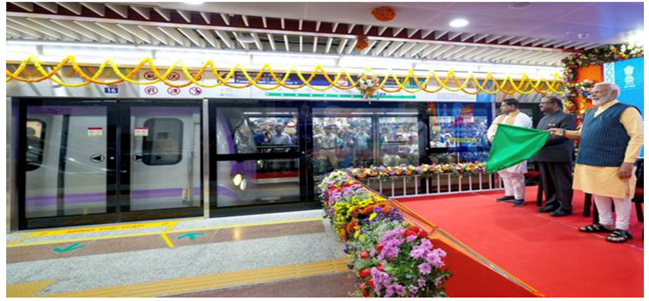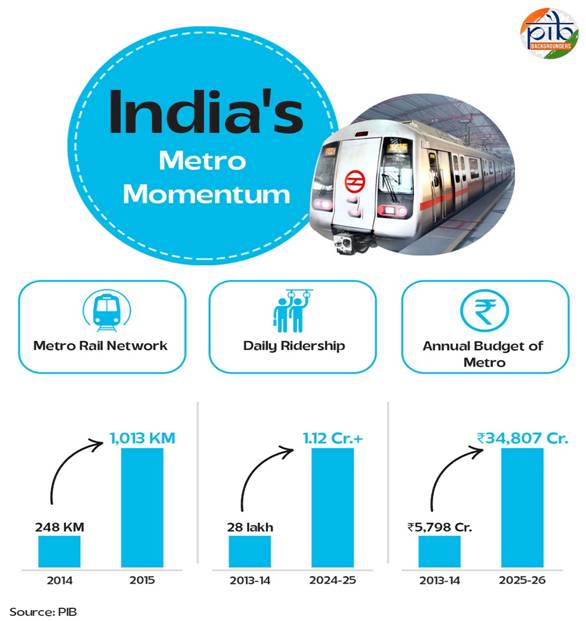Infrastructure
India’s Metro Revolution: From Miles to Milestones
Posted On: 09 AUG 2025 12:19PM
“The metro is becoming a new lifeline for the cities in modern India”
- Prime Minister Narendra Modi
|
- India’s metro network grew from 248 km (2014) to 1,013 km (2025).
- India has invested ₹2.5 lakh crore (US$ 28.86 billion) and built over 2,000 metro coaches domestically.
- Initiatives like Make in India, solar-powered stations, and driverless metros are driving clean, future-ready mobility.
|
The Rise of India’s Metro Rail

The Delhi Metro
From the first tracks laid in Delhi’s expanding suburbs in the early 2000s to the bustling, tech-powered networks now weaving over 20 Indian cities, India’s metro story is a symbol of its urban awakening. What began as a cautious step into mass rapid transit has evolved into a nationwide movement, streamlining daily commutes, reducing city congestion, and reshaping skylines. The metro is no longer just a mode of transport; it’s a lifeline pulsing through the heart of India’s growth story, driven by ambition, innovation, and a vision of sustainable urban living. India now proudly stands as the world’s third-largest metro network, reflecting its rapid strides in urban transit expansion.

Prime Minister Narendra Modi Inaugurating Kolkata Metro's Howrah Maidan - Esplanade Metro Section
|
Operational Footprint
|
- India’s operational metro network has soared from 248 km across 5 cities (in 2014) to 1,013 km across 23 cities by May 2025, adding 763 km in just 11 years.
|
- Average daily ridership has climbed from 28 lakh (2013–14) to over 1.12 crore, marking a transformative shift in urban commuting.
|
|
Metro Growth metrics
|
- The pace of commissioning new lines has accelerated ninefold: from 0.68 km/month (pre‑2014) to approximately 6 km/month today.
|
- The annual metro budget for 2025–26 is ₹34,807 crore, up more than six times from ₹5,798 crore in 2013–14.
|

Steering the Future: Key Steps by the Government
To accelerate urban mobility and ensure sustainable transit solutions, the Government of India has launched several transformative initiatives. These steps aim to ensure that metro projects are sustainable, economically viable, and technologically advanced. Through visionary policies, bold investments, and smart partnerships, the government is laying the foundation for a cleaner, faster, and more connected urban future.
Metro Rail Policy, 2017
The Metro Rail Policy 2017 mandates cities to prepare Comprehensive Mobility Plans (CMPs) and establish Urban Metropolitan Transport Authorities (UMTAs) to guide the development of metro systems with a strong emphasis on sustainability, economic viability, and integrated urban mobility. To qualify for central financial assistance, metro projects must ensure a minimum Economic Internal Rate of Return (EIRR) of 14% and involve mandatory private sector participation through Public-Private Partnerships (PPP).
Make in India for Metro Rail Systems
As part of the ambitious Make-in-India drive, the government has made provisions for domestic procurements of at least 75% of metro cars and 25% of key equipment and sub-systems—a bold step to boost local production and foster self-reliance in the mobility sector. In the last ten years, India has invested nearly ₹2.5 lakh crore (US$ 28.86 billion) into expanding its metro network. This momentum has powered the local manufacturing of metro coaches. Bharat Earth Movers Limited (BEML), a Public Sector Undertaking (PSU) under the Ministry of Defence, has supplied over 2,000 metro coaches across cities like Delhi, Jaipur, Kolkata, Bengaluru, and Mumbai as of May 2024, strengthening domestic capabilities and reducing dependence on imports.
Global Partnerships are also steering the growth of the Metro Network in the country. One such project, the Mumbai Metro Line 3 (MML-3) is expected to transform urban transit with a massive investment of ₹23,136 crore (US$ 2.67 billion). A significant share of ₹13,235 crore (US$ 1.53 billion), or 57.2% of the total funding, is being provided as loan assistance by the Japan International Cooperation Agency (JICA). The rest of the funding is being jointly contributed by the Government of India, the Maharashtra State Government/ Mumbai Metropolitan Region Development Authority (MMRDA), making it a strong example of international and domestic collaboration in infrastructure development.
India’s metro rail systems are embracing green innovations. The Delhi Metro installed a vertical bi-facial solar plant on an elevated viaduct at Okhla Vihar and a 1 MW rooftop solar plant at Khyber Pass depot, pioneering land-free renewable energy use. Other green initiatives like regenerative braking systems, widely adopted across metros, help save power and reduce carbon emissions by converting braking energy into electricity. Additionally, many metro stations in cities like Delhi, Kochi, Nagpur, and Pune have received Indian Green Building Council (IGBC) Certifications, promoting eco-friendly infrastructure. These efforts align with India’s sustainability goals and demonstrate the metro’s growing role in clean urban mobility.
Cutting-Edge Innovations in India’s Metro Rail
India’s metro systems aren’t just expanding in size, they’re evolving in intelligence. With a strong push toward automation, digitalization, and sustainability, metros across the country are embracing new technologies.
Namo Bharat Train
- India’s first state-of-the-art high-speed regional train.
- Runs at 160 km/h operational speed (design speed: 180 km/h).
- Deployed on Delhi–Meerut Regional Rapid Transit System (RRTS)
Underwater Metro
- In 2024, India achieved a major milestone by launching its first underwater metro tunnel in Kolkata, connecting the Esplanade to Howrah Maidan beneath the Hooghly River.
- This engineering marvel stands as a symbol of India’s growing technological and infrastructural prowess.
Water Metro
- Kochi, Kerala, became India’s first city to launch a Water Metro.
- The Water Metro connects 10 islands using electric-hybrid boats for seamless and eco-friendly transport.
European Train Control System ETCS Level II Signaling
- World's first ETCS Level II with Hybrid Level III system using LTE radio backbone.
- Enhances train safety, speed, and real-time monitoring on the Namo Bharat route.
Platform Screen Doors (PSD)
- Co-developed by Bharat Electronics Limited (BEL) and National Capital Region Transport Corporation (NCRTC).
- Boosts passenger safety and minimizes platform-level accidents.
National Common Mobility Card (NCMC)
- Unified One Nation, One Card solution.
- Enables seamless travel across metros, buses, suburban rail, tolls, and retail.
QR-Based Ticketing
- Mobile app-based QR tickets simplify and digitize the ticketing experience.
Unmanned Train Operations (UTO)
- Driverless tech is functional across multiple stretches of the Delhi Metro, the first of them being introduced on the Magenta Line in 2020.
- Improves efficiency and lowers human dependency.
Indigenous Automatic Train Supervision System (i-ATS)
- Developed locally for the first time in India, ATS provides automatic local and central control and monitoring of train operations and signaling.
- Jointly created by the Delhi Metro Rail Corporation (DMRC) and BEL, now active on the Red Line of the Delhi Metro.
Metro Projects in the Pipeline
India’s metro expansion continues to gather pace with a wave of new projects in the planning and approval stages. The aim is to improve last-mile connectivity, support urban growth, and offer cleaner, faster, and more inclusive public transport across emerging and established cities. Some of these upcoming projects are:
|
Pune Metro Rail Project Phase-2
- Pune Metro Phase-2, covering two elevated corridors (Vanaz–Chandani Chowk and Ramwadi–Wagholi) totaling 12.75 km with 13 stations, has been approved and scheduled for completion within four years.
- The extensions will improve access to IT hubs, educational institutions, and intercity bus terminals, enhancing the public transport share.
|
|
Delhi Metro
- Extension of the Aerocity–Tughlakabad Corridor to Indira Gandhi Domestic Terminal-1 (2.16 km, Underground).
- Magenta Line Extension (Line 8) – Ramakrishna Ashram Marg to Indraprastha (9.913 km, Underground).
- Golden Line Extension (Line 10) – Tughlakabad to Kalindi Kunj (9 km, Elevated).
- Noida Sector-51 to Knowledge Park V (17.435 km).
|
|
Ahmedabad Metro Rail Project Phase-2A
- Ahmedabad Metro Extension for direct connectivity to Sardar Vallabhbhai Patel Airport (6.032 km).
- The extension will lead to convenient and faster access to the airport for daily commuters, airport personnel, and residents across the city.
|
|
Bangalore Metro Phase-3
- 45 km of Phase-3 has been sanctioned by the Central Government at a cost of ₹15,600 crore.
- Currently, 75 km of metro is operational and 145 km is under construction in the city.
|
|
Expansion of Water Metro
- Replicating the model of Kochi Metro, the government has approved a technical feasibility study for Water Metro expansion services in 24 cities across India, including Guwahati, Dibrugarh and Tezpur in Assam.
- The expansion will help in improving connectivity, easing road congestion, and promoting sustainable transit in cities.
|
Conclusion
From the buzzing platforms of Delhi to the rising lines of Surat and Bhopal, Metros are silently stitching together the fabric of a new India: fast, efficient, and clean. These aren't just trains; they're lifelines of tomorrow’s India, delivering not just passengers, but ambition, equity, and resilience. As India aspires to become the world's third-largest economy with a projected GDP of $7.3 trillion by 2030, robust public transportation like Metro rail will be the backbone of its growth, connecting people, powering cities, and protecting the planet. With the government's continued focus and execution, India is well on track to become one of the world’s leading models of Metro-led mobility transformation.
References
Ministry of Housing & Urban Affairs
https://www.pib.gov.in/PressReleseDetailm.aspx?PRID=2101366
https://www.pib.gov.in/PressReleasePage.aspx?PRID=2147920
https://www.pib.gov.in/PressReleasePage.aspx?PRID=2104426
https://www.pib.gov.in/PressReleasePage.aspx?PRID=2011999
https://www.pib.gov.in/PressReleseDetail.aspx?PRID=2130718
https://www.pib.gov.in/PressReleasePage.aspx?PRID=2046368
https://www.pib.gov.in/PressReleasePage.aspx?PRID=1488414
https://www.pib.gov.in/PressReleseDetail.aspx?PRID=2139491
Ministry of Commerce and Industry
https://www.pib.gov.in/PressReleasePage.aspx?PRID=2132174
https://www.pib.gov.in/PressReleasePage.aspx?PRID=2136029
Ministry of Ports, Shipping and Waterways
https://www.pib.gov.in/PressReleseDetailm.aspx?PRID=2120213
Ministry of Information and Broadcasting
https://www.pib.gov.in/PressReleaseIframePage.aspx?PRID=2117488
Prime Minister’s Office
https://www.pib.gov.in/PressReleasePage.aspx?PRID=2090307
https://www.pib.gov.in/PressReleasePage.aspx?PRID=1944623
Cabinet
https://www.pib.gov.in/newsite/PrintRelease.aspx?relid=170009
PIB Backgrounders
https://www.pib.gov.in/PressNoteDetails.aspx?NoteId=153629&ModuleId=3
https://www.pib.gov.in/PressNoteDetails.aspx?ModuleId=3&NoteId=154624
IBEF
https://www.ibef.org/blogs/india-s-expanding-metro-network-transforming-urban-mobility-and-boosting-economic-growth
Other Links
https://delhitourism.gov.in/itinerary/metro_itinerary.html
Click here to see PDF
*****
SK/M
(Backgrounder ID: 155002)
Visitor Counter : 166
Read this release in:
Hindi